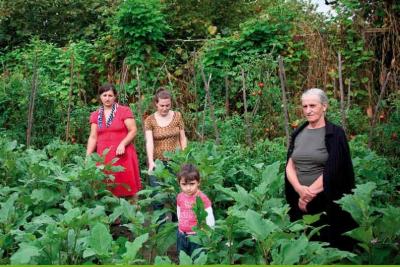Pervasive Gender Inequality in Rural Areas
Date:
Rural households that are headed by women, suffer more from poverty than those headed by men. Social and cultural barriers, a lack of kindergartens, as well as the burden of unpaid housework, prevent women from developing their skills and from generating an income. Despite the clear gender inequalities, policies and strategies at the agricultural, regional and village level lack the necessary approaches to tackle these issues.

Rural women in Georgia; Photo: UN Women/Justyna Melnikievicz
Financial constraints and women’s double work burden
The results of the study are grave: 90% of those surveyed reported experiencing financial difficulties, and 54% of households, where the main breadwinner is a woman, reported that they are hardly able to buy food; compared with 39% of those households headed by men. Women, however, work more hours than men in all regions except Shida Kartli; when work both inside and outside of the household is combined, focus group data indicates that women work between 2.5 hours (in Samegrelo) and 8 hours (in Kakheti) more than men, every day.
There is a gendered division of labor in agricultural value chains, where in most regions, women are concentrated in the animal husbandry value chain and men in the value chain for crops. However, when the two are combined, women engage in agricultural activities 80 days more per year than men, on average. Despite this, the prevailing stereotypes prescribe that women should stay at home and look after children; and their work is not being recognized.
Limited access to training, advice and services
Despite the fact that a large majority of the population surveyed are involved in farming, the study shows that there is limited access to agricultural education, and that only one in ten had heard of the existing extension services. With regards to knowledge of such services, there was a 20 percentage point difference between women’s and men’s awareness (with women being less informed than men). An absolute majority of those surveyed only produced agricultural products for their own consumption. Only 20% planned to engage in farming for income generation (of those 40% are women and 60% are men) and less than one percent are members of a functioning cooperative. According to data from the Cooperatives Agency of the Ministry of Agriculture, women constitute 25% of the membership base of cooperatives.
Low rates of participation in local decision-making processes
Moreover, access to certain social services is a challenge. The study shows that 30% of the population lacks access to kindergartens, with the situation being most acute in the Kvemo Kartli and Samtskhe-Javakheti regions, where more than half of the population lacks access. These are regions with a relatively high proportion of ethnic minorities, and where there is already a risk of marginalization and isolation due to language and cultural barriers. Provision of social infrastructure is not only a social issue but an economic and political one as well. Access to childcare and other care services may greatly impact on a woman’s ability to have time free for activities outside of household chores; for example generating an income, participating in local decision-making and development, or simply for leisure.
Despite clear development needs in the targeted regions, almost 90% of those surveyed indicated that they do not participate in local decision-making processes. In the target regions of the study, the average level of formal representation of women in sakrebulos (municipal councils) is 9%. Key informants indicated that women rarely participate in public discussions on community development issues (namely the Village Support Programme meetings, launched by the Ministry of Regional Development and Infrastructure).
Promising initiatives and recommendations going forward
The study also makes recommendations at the policy, programme, services and grassroots level, and identifies a number of promising practices for increased attention and support. Some of the key recommendations include: Coordination and gender mainstreaming of national and regional strategies; collection of sex-disaggregated data; ensuring out-reach to women as beneficiaries of the services and programmes; support to gender advisors and gender-responsive budgeting at the municipal level. Among the promising practices identified are programmes that support women who are small-scale farmers to access markets, as well as initiatives to form local self-help groups of women and men that cooperate with municipalities to identify and address community needs.
Read the full report here.